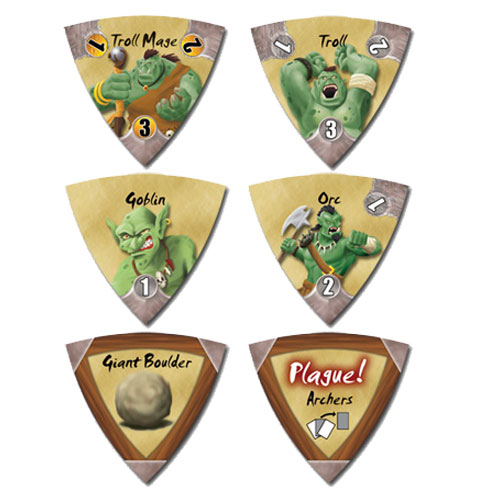
GAME DESCRIPTION: Castle Panic is a co-operative strategy board game published by Fireside Games for 1 to 6 players. Players work together to defend their castle from jealous enemy monsters. There are 3 modes to play, but this review will only cover Standard.
SET-UP: The game board contains 5 labeled rings going inward, and is split into 6 numbered segments. Place 1 Tower into each of the 6 segments, separated into 3 colors, in the Castle Ring, and 1 Wall in between the Castle and Swordsman Ring. Take 3 Goblin Monster Tokens, 2 Orc Monster Tokens, and 1 Troll Monster Token. Place only 1 Monster Token in each segment in the Archer Ring, with the highest number on the token facing the castle. Shuffle the Castle cards, and deal cards face-up to each player, with the number dependent on the number of players. Place the rest of the deck face-down. Finally, turn all the Monster Tokens face-down and mix them up.
STARTING: The turn player starts by drawing back up to your hand limit, which is usually ignored at the first turn. Then, the player may discard 1 card and draw a replacement in its place, or skip this step. The 3rd step allows trading between players. If there are 2 to 5 players, a player can only make one trade per turn. With 6 players, a player may trade either 2 cards with the same player or trade with 2 different players.
FIGHT: During this turn, the turn player may play as may cards as they wish and are able. A player may attack any monsters not in the forest during this turn by playing the card that matches both the color and Ring of the location of the monster. Rotate the token so the next lowest number is facing the castle to indicate 1 damage taken, unless otherwise stated on the card.

SLAYING: Once a Monster Token is at 1, and takes damage, it is removed from the board and given to the player who slayed it as a Trophy. Any Monster that is slayed from a Boulder or other event is not given to any player.
MOVEMENT: Once the player cannot or chooses not to play anymore cards, every Monster Token advances 1 Ring forward. Any Monster that gets to a Wall destroys the Wall and takes 1 damage. If the Wall is fortified, the Fortification token is removed, and the Monster takes 1 damage. If there is no Wall, the Monster advances into the Castle Ring, and that Castle is destroyed and the monster takes 1 damage.
REINFORCEMENT: Once the Monsters have moved, the player flips over 2 Monster Tokens and places them into the Forest Ring, the location determined by dice roll. There are also special tokens, such as Boss Monsters. Boss Monsters also have special effects detailed in the rules, and can be identified by the gold background behind their damage points. There are also Plague tokens, which discards the indicated card from everyone's hands. There are also Tokens that rotate every Monster one number clockwise/counter-clockwise, move Monsters forward in a specific color, or force the player to draw more Monster Tokens.
GIANT BOULDER: The Giant Boulder rolls down a numbered segment determined by dice roll, and destroys any Monsters it passes until it hits and destroys either a Wall, Tower, or Fortification. If none of these things are in the way, it continues through to the other side and destroys any other enemies and stops after it hits the next Forest ring.

FINISHING: If the Monsters manage to destroy all Wall and Castle segments, the players lose. If the players manage to play and slay all 49 Monsters, the players win. In that case, each player adds up the highest number on each of their Trophies. The player with the highest number of points is now the Master Slayer.
CONCLUSION: I am a sucker for Co-operative games. This is probably one of the first ones I've ever played, and it plays well. The game is punishing and difficult, but not terribly so. Castle Panic has enough randomness and player support to make it work. However, it is still a strategy game, which means that even though you can have players help and guide you, or just straight up tell you what to do, if you don't enjoy turn based strategy, it won't be fun. This is the kind of game that changes on a whim, and well laid plans can be swept out from under you in a heartbeat. Still, with a solid group of friends who understand long term strategy, you should at least attempt it, if only to see if you like strategy games or not.
AFTERTHOUGHTS: There are 2 more variations of play of Castle Panic. The first, Co-op, just eliminates Trophies, so it might be good to play with younger people who struggle with this game, or players who have a habit of ruining a plan so they can score. The other version, Overlord, seems to make it more of an asynchronous 1 vs 3-5 game, which might be fascinating to try.










